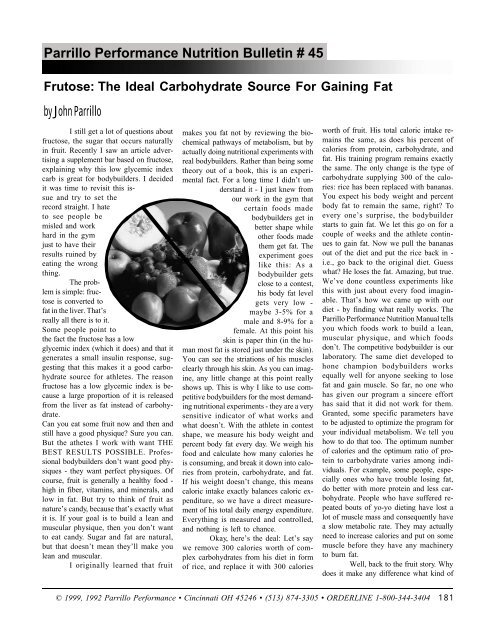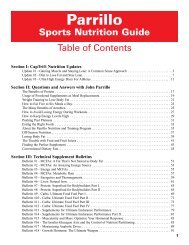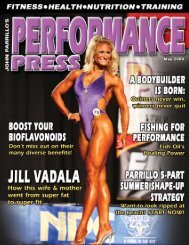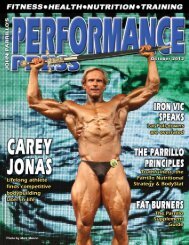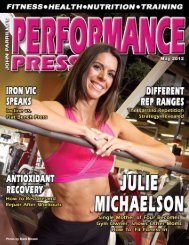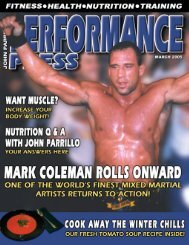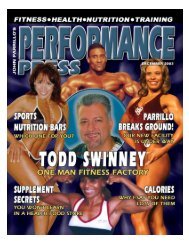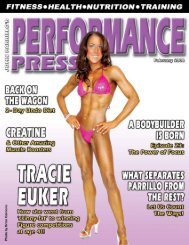Parrillo Performance Nutrition Bulletin # 45 by John Parrillo
Parrillo Performance Nutrition Bulletin # 45 by John Parrillo
Parrillo Performance Nutrition Bulletin # 45 by John Parrillo
You also want an ePaper? Increase the reach of your titles
YUMPU automatically turns print PDFs into web optimized ePapers that Google loves.
<strong>Parrillo</strong> <strong>Performance</strong> <strong>Nutrition</strong> <strong>Bulletin</strong> # <strong>45</strong><br />
Frutose: The Ideal Carbohydrate Source For Gaining Fat<br />
<strong>by</strong> <strong>John</strong> <strong>Parrillo</strong><br />
I still get a lot of questions about<br />
fructose, the sugar that occurs naturally<br />
in fruit. Recently I saw an article advertising<br />
a supplement bar based on fructose,<br />
explaining why this low glycemic index<br />
carb is great for bodybuilders. I decided<br />
it was time to revisit this issue<br />
and try to set the<br />
record straight. I hate<br />
to see people be<br />
misled and work<br />
hard in the gym<br />
just to have their<br />
results ruined <strong>by</strong><br />
eating the wrong<br />
thing.<br />
The problem<br />
is simple: fructose<br />
is converted to<br />
fat in the liver. That’s<br />
really all there is to it.<br />
Some people point to<br />
the fact the fructose has a low<br />
glycemic index (which it does) and that it<br />
generates a small insulin response, suggesting<br />
that this makes it a good carbohydrate<br />
source for athletes. The reason<br />
fructose has a low glycemic index is because<br />
a large proportion of it is released<br />
from the liver as fat instead of carbohydrate.<br />
Can you eat some fruit now and then and<br />
still have a good physique? Sure you can.<br />
But the athetes I work with want THE<br />
BEST RESULTS POSSIBLE. Professional<br />
bodybuilders don’t want good physiques<br />
- they want perfect physiques. Of<br />
course, fruit is generally a healthy food -<br />
high in fiber, vitamins, and minerals, and<br />
low in fat. But try to think of fruit as<br />
nature’s candy, because that’s exactly what<br />
it is. If your goal is to build a lean and<br />
muscular physique, then you don’t want<br />
to eat candy. Sugar and fat are natural,<br />
but that doesn’t mean they’ll make you<br />
lean and muscular.<br />
I originally learned that fruit<br />
makes you fat not <strong>by</strong> reviewing the biochemical<br />
pathways of metabolism, but <strong>by</strong><br />
actually doing nutritional experiments with<br />
real bodybuilders. Rather than being some<br />
theory out of a book, this is an experimental<br />
fact. For a long time I didn’t understand<br />
it - I just knew from<br />
our work in the gym that<br />
certain foods made<br />
bodybuilders get in<br />
better shape while<br />
other foods made<br />
them get fat. The<br />
experiment goes<br />
like this: As a<br />
bodybuilder gets<br />
close to a contest,<br />
his body fat level<br />
gets very low -<br />
maybe 3-5% for a<br />
male and 8-9% for a<br />
female. At this point his<br />
skin is paper thin (in the human<br />
most fat is stored just under the skin).<br />
You can see the striations of his muscles<br />
clearly through his skin. As you can imagine,<br />
any little change at this point really<br />
shows up. This is why I like to use competitive<br />
bodybuilders for the most demanding<br />
nutritional experiments - they are a very<br />
sensitive indicator of what works and<br />
what doesn’t. With the athlete in contest<br />
shape, we measure his body weight and<br />
percent body fat every day. We weigh his<br />
food and calculate how many calories he<br />
is consuming, and break it down into calories<br />
from protein, carbohydrate, and fat.<br />
If his weight doesn’t change, this means<br />
caloric intake exactly balances caloric expenditure,<br />
so we have a direct measurement<br />
of his total daily energy expenditure.<br />
Everything is measured and controlled,<br />
and nothing is left to chance.<br />
Okay, here’s the deal: Let’s say<br />
we remove 300 calories worth of complex<br />
carbohydrates from his diet in form<br />
of rice, and replace it with 300 calories<br />
worth of fruit. His total caloric intake remains<br />
the same, as does his percent of<br />
calories from protein, carbohydrate, and<br />
fat. His training program remains exactly<br />
the same. The only change is the type of<br />
carbohydrate supplying 300 of the calories:<br />
rice has been replaced with bananas.<br />
You expect his body weight and percent<br />
body fat to remain the same, right? To<br />
every one’s surprise, the bodybuilder<br />
starts to gain fat. We let this go on for a<br />
couple of weeks and the athlete continues<br />
to gain fat. Now we pull the bananas<br />
out of the diet and put the rice back in -<br />
i.e., go back to the original diet. Guess<br />
what? He loses the fat. Amazing, but true.<br />
We’ve done countless experiments like<br />
this with just about every food imaginable.<br />
That’s how we came up with our<br />
diet - <strong>by</strong> finding what really works. The<br />
<strong>Parrillo</strong> <strong>Performance</strong> <strong>Nutrition</strong> Manual tells<br />
you which foods work to build a lean,<br />
muscular physique, and which foods<br />
don’t. The competitive bodybuilder is our<br />
laboratory. The same diet developed to<br />
hone champion bodybuilders works<br />
equally well for anyone seeking to lose<br />
fat and gain muscle. So far, no one who<br />
has given our program a sincere effort<br />
has said that it did not work for them.<br />
Granted, some specific parameters have<br />
to be adjusted to optimize the program for<br />
your individual metabolism. We tell you<br />
how to do that too. The optimum number<br />
of calories and the optimum ratio of protein<br />
to carbohydrate varies among individuals.<br />
For example, some people, especially<br />
ones who have trouble losing fat,<br />
do better with more protein and less carbohydrate.<br />
People who have suffered repeated<br />
bouts of yo-yo dieting have lost a<br />
lot of muscle mass and consequently have<br />
a slow metabolic rate. They may actually<br />
need to increase calories and put on some<br />
muscle before they have any machinery<br />
to burn fat.<br />
Well, back to the fruit story. Why<br />
does it make any difference what kind of<br />
© 1999, 1992 <strong>Parrillo</strong> <strong>Performance</strong> • Cincinnati OH <strong>45</strong>246 • (513) 874-3305 • ORDERLINE 1-800-344-3404 181
Frutose: The Ideal Carbohydrate Source For Gaining Fat<br />
food you eat? For a given number of calories<br />
it seems like it shouldn’t matter what<br />
foods they come from. This is one of the<br />
most common mistakes people make<br />
when trying to lose fat. They think that if<br />
they reduce calories they will automatically<br />
lose weight. This is true, but only<br />
for a little while. And if you lose weight<br />
<strong>by</strong> drastically reducing calories, about 50%<br />
of the weight lost will be muscle. What<br />
people fail to realize is that the types of<br />
foods you eat is just as important as how<br />
many calories you consume. If cutting<br />
calories was the answer, then those low<br />
calorie weight loss drinks would work,<br />
but they don’t.<br />
The key point is that different<br />
foods have different chemical compositions<br />
and therefore have different effects<br />
inside your body. Of course, all food is<br />
fuel, but what type of fuel it is matters a<br />
lot. Try putting kerosene in your car sometime<br />
and see how it runs. For any machine<br />
to run optimally, including the human<br />
body, it requires the right kind of fuel.<br />
The problem with fruit is that virtually all<br />
of the calories it supplies come in the form<br />
of simple sugars. The most abundant<br />
sugar in fruit is fructose (commonly<br />
known as fruit sugar), although some<br />
fruits (oranges and grapes for example)<br />
also contain a lot of glucose. The problem<br />
with fructose is that it <strong>by</strong>passes the<br />
enzyme phosphofructokinase-I (PFK-I),<br />
the rate limiting step of glycolysis, the<br />
pathway responsible for the conversion<br />
of carbohydrate into energy (1). In other<br />
words fructose <strong>by</strong>passes the control point<br />
that decides if a dietary sugar is going to<br />
be stored as glycogen or fat. Complex<br />
carbohydrates such as rice, oatmeal, and<br />
potatoes, are preferentially stored as glycogen<br />
until glycogen stores are full. Fructose,<br />
on the other hand, gets directly converted<br />
to fat in the liver, then gets whisked<br />
off in the bloodstream to be stored in fat<br />
cells (1).<br />
As you know from our previous<br />
articles about carbohydrate metabolism<br />
and thermogenesis, the dietary energy<br />
(calories) supplied <strong>by</strong> carbs is used for<br />
several purposes. Some of it is simply lost<br />
as heat during its digestion and metabolism<br />
in a process we know as diet-induced<br />
thermogenesis. You can loosely think of<br />
this as “friction” in the metabolic pathway,<br />
and this energy loss contributes to<br />
the generation of body heat. Most of the<br />
dietary energy is used to maintain the basal<br />
metabolic rate (BMR) - the energy cost<br />
of keeping your body alive. Some of the<br />
energy is used to perform work, like exercise<br />
and just tending to the activities of<br />
daily life. After that, any energy left is<br />
stored as glycogen in muscles and in the<br />
liver. If you consume too many calories<br />
from carbohydrate, after glycogen stores<br />
are full the rest will be converted<br />
to fat (triglycerides) in<br />
the liver, and transported <strong>by</strong><br />
the blood to fat cells (adipose<br />
tissue) for storage.<br />
So after glycogen stores are<br />
full, excess calories from any<br />
type of carbohydrate can be<br />
converted to fat. The enzyme<br />
that regulates whether dietary<br />
energy supplied <strong>by</strong> carbohydrate<br />
is stored as glycogen or<br />
fat is PFK-I. It shuttles carbs<br />
into glycogen stores until<br />
they’re full, then it switches<br />
the flow of carbohydrates<br />
from glycogen synthesis to<br />
fat synthesis. Glycogen is the<br />
storage form of carbohydrate<br />
in animals, and the<br />
amount of glycogen you can<br />
store is quite limited. The upper<br />
limit is generally believed<br />
to be 250-400 grams, depending<br />
on the amount of<br />
skeletal muscle mass you<br />
have. (Very massive bodybuilders may be<br />
able to store as much as 600 grams.) This<br />
amounts to only 1000-1600 calories - not<br />
even enough energy to fuel your body for<br />
one day. The deal with fructose is that it<br />
totally skips the enzyme PFK-I, which is<br />
the regulatory step responsible for making<br />
sure glycogen stores are full before<br />
fat synthesis is switched on. Instead of<br />
being stored as glycogen, fructose gets<br />
directly converted to fat <strong>by</strong> the liver. Now<br />
I think you can see why I have a problem<br />
with recommending fruit for bodybuilders.<br />
To get a detailed understanding<br />
of fructose metabolism we should start<br />
at the beginning. Fructose is absorbed<br />
from the small intestine and transported<br />
to the liver <strong>by</strong> the portal vein. You have to<br />
realize that fructose itself is not released<br />
from the liver into the bloodstream to reach<br />
the rest of the body. Any carbohydrate<br />
source you ingest is first converted to glucose<br />
<strong>by</strong> the liver, and glucose (“blood<br />
sugar”) is the carbohydrate source used<br />
<strong>by</strong> muscles and the form of carbohydrate<br />
which is converted into glycogen. The first<br />
enzyme to act on fructose is fructokinase,<br />
which adds a phosphate group to the<br />
sugar to form fructose-1-phosphate<br />
(F1P). Glucose is similarly phosphorylated<br />
at the 6 position <strong>by</strong> the enzyme hexokinase,<br />
forming G6P. All cells have hexokinase,<br />
and thus have the ability to phosphorylate<br />
glucose. This means that all cells<br />
can metabolize glucose for energy. On the<br />
other hand, fructokinase is virtually confined<br />
to the liver (1). So while glucose is<br />
a general substrate for all body tissues,<br />
fructose represents a carbohydrate load<br />
182 © 1999, 1992 <strong>Parrillo</strong> <strong>Performance</strong> • Cincinnati OH <strong>45</strong>246 • (513) 874-3305 • ORDERLINE 1-800-344-3404
Frutose: The Ideal Carbohydrate Source For Gaining Fat<br />
targeted for the liver (1). The next thing<br />
that happens is F1P is split <strong>by</strong> the enzyme<br />
aldolase to form glyceraldehyde (GA) and<br />
dihydroxyacetone phosphate (DHAP).<br />
This means that the products of fructose<br />
metabolism enter the glycolytic pathway<br />
at the triose phosphate level (i.e., as three<br />
carbon sugars). Glucose, on the other<br />
hand, is phosphorylated to yield G6P,<br />
which may proceed directly to glycogen<br />
synthesis (1). To be broken down for<br />
energy glucose must first pass through<br />
the rate-limiting PFK-I step. Fructose metabolites<br />
enter below this step, and thus<br />
<strong>by</strong>pass an important point of regulation.<br />
Fructose therefore is more prone to be<br />
converted to fat, while glucose is more<br />
prone to be converted to glycogen.<br />
The biochemistry is much more<br />
complex than is appropriate for this article,<br />
but I have pointed out the salient features<br />
of the pathway to explain why glucose-based<br />
carbohydrate sources are better<br />
than fructose, especially for people<br />
trying to minimize body fat stores. Scientific<br />
studies have proven that starch (glucose<br />
polymer) is much more efficient at<br />
replenishing skeletal muscle glycogen<br />
stores than fructose (2). Now you understand<br />
why — muscle cells don’t have<br />
the enzyme needed to phosphorylate fructose,<br />
so its metabolism is essentially limited<br />
to the liver.<br />
When we were designing the<br />
<strong>Parrillo</strong> <strong>Performance</strong> Bar, we surveyed<br />
every available sports supplement bar we<br />
could find. We found that 25 out of the<br />
26 bars had fructose in either the first or<br />
second ingredient. (If you use somebody<br />
else’s bar, go read the label.) Why? Because<br />
corn syrup and fruit juice (good<br />
sources of fructose) are real cheap, and<br />
they’re also very sweet. We pioneered the<br />
use of a new carbohydrate source in the<br />
<strong>Parrillo</strong> Bar called rice dextrin. It’s a shortchain<br />
glucose polymer made from rice.<br />
This gives you the quick energy you want<br />
from a sports bar, but without the fructose.<br />
Each Bar also contains CapTri<br />
(which is legendary <strong>by</strong> now) and an ultra-high<br />
efficiency protein source.<br />
As we discussed in an earlier article about<br />
carbohydrate metabolism, complex carbohydrates<br />
(such as starch and<br />
maltodextrin) are more effective in replenishing<br />
glycogen stores than simple sugars<br />
(3). This makes sense because complex<br />
carbs are released into the bloodstream<br />
slowly whereas simple sugars are<br />
released very rapidly, potentially overwhelming<br />
the glycogen synthesis pathways<br />
and “spilling over” into fat stores.<br />
Furthermore, the increased insulin release<br />
resulting from simple sugars causes more<br />
of the sugar to be converted to fat.<br />
This is why <strong>Parrillo</strong> <strong>Performance</strong> ProCarb<br />
is based on maltodextrin instead of sugar,<br />
like most other carbohydrate supplements.<br />
Maltodextrin is a medium-chain glucose<br />
polymer. It has been found that<br />
maltodextrin is 15% more efficient at restoring<br />
muscle glycogen levels than conventional<br />
carbohydrate foods like rice and<br />
pasta (4). This makes ProCarb ideal for<br />
glycogen supercompensation (carb loading).<br />
Maltodextrin beverages like Pro-Carb<br />
have also been demonstrated to increase<br />
blood glucose levels during exercise and<br />
to increase exercise time to exhaustion<br />
(4,5).<br />
At this point, I think I can anticipate<br />
a question from the biochemists in<br />
the crowd. You’ve probably heard that<br />
fructose is low on the glycemic index,<br />
which means it raises blood sugar very<br />
slowly and elicits only a small insulin response.<br />
From your reading of our series<br />
on endocrinology, you know that a slow,<br />
steady insulin response is good. Since insulin<br />
is a potent stimulus for fat storage,<br />
we want to keep insulin levels fairly low,<br />
so <strong>by</strong> this reasoning it seems like fructose<br />
would be good. The problem is that<br />
the REASON fructose has a low glycemic<br />
index and results in a small insulin<br />
release is that it is converted to fat in the<br />
liver. It doesn’t raise blood sugar very<br />
much because it is released from the liver<br />
as fat instead of sugar. Fructose has a<br />
MUCH greater tendency to be converted<br />
to fat than other carbohydrate sources,<br />
so why use it? Now you understand the<br />
biochemistry behind my controversial<br />
stance on fruit.<br />
Now I’d like to go into a little<br />
more detail about carbohydrate metabolism<br />
and glycogen storage. After exercise<br />
is completed dietary carbohydrate is directed<br />
toward restoring muscle and liver<br />
glycogen and returning blood glucose to<br />
normal levels. Dietary starches and sugars<br />
are digested to simple sugars (glucose<br />
and fructose) which are then available for<br />
glycogen formation (2). Until recently it<br />
was believed that glycogen was made just<br />
from glucose extracted from the blood<br />
<strong>by</strong> the liver and muscle, but the actual<br />
dynamics of glycogen restitution turn out<br />
to be much more complicated. In fact,<br />
glucose serves primarily to replenish<br />
muscle glycogen stores, while the liver is<br />
more versatile in its choice of substrates<br />
(building blocks) for glycogen synthesis.<br />
The liver is able to make glycogen from<br />
fructose, lactate, glycerol, alanine, and<br />
other three-carbon metabolites (2). Amazingly,<br />
most glucose absorbed from the gut<br />
actually travels through the liver without<br />
being absorbed and preferentially is used<br />
to replenish muscle glycogen stores (2).<br />
This is cutting edge stuff, folks, that you<br />
probably won’t hear anywhere else. I<br />
don’t know of anyone besides <strong>Parrillo</strong><br />
<strong>Performance</strong> who researches nutritional<br />
biochemistry and metabolism at this level<br />
of molecular detail to instruct bodybuilders<br />
on exact techniques to control the flow<br />
of energy and nutrients through the metabolic<br />
pathways. Who else teaches you<br />
© 1999, 1992 <strong>Parrillo</strong> <strong>Performance</strong> • Cincinnati OH <strong>45</strong>246 • (513) 874-3305 • ORDERLINE 1-800-344-3404 183
Frutose: The Ideal Carbohydrate Source For Gaining Fat<br />
how to control the metabolic pathways<br />
to optimize bodybuilding results?<br />
Anyway, what happens is this: After exercise<br />
liver and muscle glycogen (carbohydrate)<br />
stores are depleted. The liver is<br />
a very versatile metabolic engine and is<br />
able to recover its glycogen stores from<br />
many different sources, including lactate,<br />
fructose, glucose, and amino acid metabolites.<br />
Muscle tissue, on the other hand,<br />
has a specialized function (contraction)<br />
and doesn’t have all of the various enzymes<br />
the liver does which allow the liver<br />
to inter-convert so many different metabolic<br />
intermediates. Muscle tissue relies<br />
on glucose to recover its glycogen store,<br />
so the liver is kind enough to let the glucose<br />
pass on through so it can be delivered<br />
to muscle. The liver makes due with<br />
other carbon compounds which muscle<br />
is unable to use. What does this mean for<br />
us bodybuilders? Think about it - the answer<br />
is right in front of you.<br />
What this means is if you feed<br />
your body glucose - the form of carbohydrate<br />
in starch, Pro-Carb, and the<br />
<strong>Parrillo</strong> Bar - the carbohydrate will be directed<br />
to your muscles and stored there<br />
as glycogen. Dietary carbohydrate in the<br />
form of glucose will be directed to your<br />
muscles until muscle glycogen stores are<br />
full. This will make your muscle full, hard,<br />
and pumped. Also, this will give you more<br />
energy and strength during your workouts,<br />
since muscles rely on their internal<br />
glycogen stores as fuel for anaerobic exercise.<br />
After muscle glycogen stores are<br />
full additional glucose will be used to restore<br />
liver glycogen. Only after both<br />
muscle and liver glycogen stores are fully<br />
repleted will further excess glucose be converted<br />
to fat. (Studies have shown that<br />
overfeeding as much as a 500 gram carbohydrate<br />
load leads to practically no fat<br />
synthesis, because the carbs are stored<br />
as glycogen.) The story with fructose is<br />
very different, indeed. Muscle does not<br />
have the enzymatic machinery needed to<br />
convert fructose into glycogen, so fructose<br />
represents a dietary carbohydrate load<br />
targeted for the liver (1,2). In the liver,<br />
two things can happen with fructose.<br />
First, fructose can be absorbed <strong>by</strong> the liver<br />
cells, converted to glucose, and then<br />
stored as glycogen. Second, the fructose<br />
can be converted to fat. You remember<br />
what I said earlier about the enzyme PFK-<br />
I. This is the “rate limiting” enzyme that<br />
operates as a switch to decide if a sugar<br />
gets stored as glycogen or converted to<br />
fat. Fructose completely <strong>by</strong>passes this<br />
enzyme and is readily converted to fat <strong>by</strong><br />
the liver. This is why ordinary table sugar<br />
increases blood triglyceride levels and<br />
makes you fat. Table sugar is a disaccharide<br />
known as sucrose, and is made from<br />
one molecule of glucose connected to one<br />
molecule of fructose. Recent thought on<br />
carbohydrate metabolism suggests that it<br />
is the fructose portion of sucrose that is<br />
responsible for making sweets so fattening.<br />
So a large portion of the fructose<br />
simply gets converted directly to fat<br />
and released into the bloodstream. Bam.<br />
You get a dose of fat. But the damage<br />
doesn’t stop there. The rest of the fructose<br />
gets converted into liver glycogen.<br />
That sounds okay, until you stop to think<br />
about it. You see, once liver glycogen<br />
stores are full the liver says, “We’ve got<br />
all the glycogen we can hold, so any more<br />
carbs coming in here we’ll just convert<br />
to fat.” Fructose preferentially repletes<br />
liver glycogen instead of muscle glycogen<br />
(2) and shifts the liver into fat-storing<br />
mode. This is exactly what we don’t<br />
want. We need some liver glycogen, to<br />
be sure, because this is what keeps blood<br />
sugar levels steady. But when liver glycogen<br />
stores are full, this is when dietary<br />
carbs start to “spill over” into fat stores.<br />
The third problem is that fructose cannot<br />
be used to replenish muscle glycogen, so<br />
on a high fructose diet liver glycogen<br />
stores are filled and we start converting<br />
carbs into fat without ever filling muscle<br />
glycogen stores. This scenario is a carbohydrate<br />
nightmare. Fructose is the<br />
worst carb source for bodybuilders you<br />
can imagine. If you wanted to design a<br />
supplement to ruin a bodybuilder’s physique,<br />
it would be a fructose-based energy<br />
bar. Unfortunately, the vast majority<br />
of the bars out there rely on fructose as<br />
their major carb source, because it’s<br />
cheap.<br />
In summary, fructose does three<br />
things: a large portion of it is converted<br />
directly to fat <strong>by</strong> the liver, it preferentially<br />
fills liver glycogen stores so that even<br />
good carbs are more prone to spill over<br />
into fat, and it cannot be used <strong>by</strong> muscle<br />
to recover glycogen. Calorie for calorie,<br />
the only nutrient that will make you fatter<br />
than fructose is fat itself. Besides that, I<br />
don’t have a problem with it.<br />
Glucose then has some special<br />
metabolic properties that you can use to<br />
your advantage. Exercise induces muscle<br />
to be more sensitive to the effects of insulin,<br />
so blood glucose is shuttled preferentially<br />
to glycogen-depleted muscle (2).<br />
Interestingly, and fortunately for the bodybuilder,<br />
high blood glucose and insulin levels<br />
do relatively little to stimulate hepatic<br />
(liver) glycogenesis (glycogen production).<br />
Instead, most glucose passes on<br />
through the liver and is extracted <strong>by</strong> skeletal<br />
muscle. This means that if you supply<br />
your body with carbohydrate in the<br />
In the liver, two things can happen with fructose. First,<br />
fructose can be absorbed <strong>by</strong> the liver cells, converted<br />
to glucose, and then stored as glycogen. Second,<br />
the fructose can be converted to fat. You remember<br />
what I said earlier about the enzyme PFK-I. This is<br />
the “rate limiting” enzyme that operates as a switch to<br />
decide if a sugar gets stored as glycogen or converted<br />
to fat. Fructose completely <strong>by</strong>passes this enzyme<br />
and is readily converted to fat <strong>by</strong> the liver.<br />
184 © 1999, 1992 <strong>Parrillo</strong> <strong>Performance</strong> • Cincinnati OH <strong>45</strong>246 • (513) 874-3305 • ORDERLINE 1-800-344-3404
Frutose: The Ideal Carbohydrate Source For Gaining Fat<br />
form of glucose post-exercise that the<br />
calories will be preferentially stored as<br />
muscle glycogen. An excellent recovery<br />
trick is to eat a <strong>Parrillo</strong> Bar or a scoop of<br />
Pro-Carb right after your workout. These<br />
are essentially “free” calories which you<br />
know will end up in muscle and not be<br />
converted to fat. If you eat a fructosebased<br />
supplement bar, however, the calories<br />
just stay in your liver and get converted<br />
either to liver glycogen or fat. It<br />
won’t help recover muscle glycogen.<br />
In closing I’d like to talk about<br />
the kinetics (time course) of glycogen storage.<br />
Glycogen recovery following exercise<br />
is highly dependent on the carbohydrate<br />
content of the diet, up until 500-600<br />
grams of carbohydrate are provided.<br />
Above this intake, glycogen synthesizing<br />
pathways appear to be saturated (2). Interestingly,<br />
not only is the absolute carbohydrate<br />
content of the diet important,<br />
but the type of dietary carbohydrate consumed<br />
is key also. A study <strong>by</strong> Costill (reviewed<br />
in reference 2) compared the relative<br />
efficacies of simple sugars versus<br />
complex carbohydrates in restoring<br />
muscle glycogen following exercise. Both<br />
were equally effective during the first 24<br />
hours of glycogen synthesis, but <strong>by</strong> 48<br />
hours post-exercise the complex carbs<br />
resulted in significantly better recover of<br />
muscle glycogen stores. Another study<br />
looked at the effects of different carbohydrate<br />
types on liver glycogen, and demonstrated<br />
that fructose is more efficient<br />
than glucose at replenishing liver glycogen.<br />
The question is, do you want your<br />
carbs to be stored in muscle or in your<br />
liver?<br />
Basically, this means if you rely<br />
on simple sugars or fructose, within 24<br />
hours your muscles will have stored as<br />
much glycogen as they can, and any further<br />
carbohydrate you consume will be<br />
converted to fat. On the other hand if you<br />
use starches (complex carbs made from<br />
glucose polymers) not only can you<br />
achieve higher levels of muscle glycogen<br />
storage, but also less of the carbs will be<br />
converted to fat. In other words, if you<br />
store more of your dietary carbs as muscle<br />
glycogen, less will be available for conversion<br />
to fat. Pretty neat, huh?<br />
You know that weight lifting is an anaerobic<br />
exercise that relies on muscle glycogen<br />
as the primary fuel source. You also know<br />
that muscles fully loaded with glycogen<br />
are bigger, harder, and stronger. What can<br />
you do to target dietary carbohydrate to<br />
muscle? Use complex carbohydrates made<br />
from glucose polymers as your carb<br />
source. This is the type of carbohydrate<br />
found in starchy foods (potatoes, rice,<br />
beans, oatmeal, etc.) and in the <strong>Parrillo</strong><br />
Bar and in Pro-Carb. Eat a high carbohydrate<br />
diet; usually 60-70% of your calories<br />
should come from complex carbs. Eat<br />
a high carbohydrate meal immediately after<br />
training, when muscles are glycogen<br />
depleted and are primed to store carbohydrate.<br />
A convenient way to do this is to<br />
put a <strong>Parrillo</strong> Bar in your gym bag or else<br />
a shaker bottle with a scoop of Pro-Carb<br />
in it. This is also an ideal time to consume<br />
some protein to provide amino acids to<br />
rebuild your muscles. If you’re trying to<br />
pack on a few more pounds of muscle it<br />
may be as simple as eating a scoop of<br />
Pro-Carb plus a scoop of Hi-Protein Powder<br />
right after your workout. Do this for<br />
a month and I can virtually guarantee<br />
you’ll see a difference. After a workout,<br />
these calories will go straight to muscle<br />
with virtually no risk of being converted<br />
to fat. Finally, avoid fructose. Most of the<br />
supplement bars out there (probably 90%<br />
of them at least) use fructose, high fructose<br />
corn syrup, or fruit juice as one of<br />
their main ingredients. Beware. These<br />
products are not effective in recovery of<br />
muscle glycogen and instead are targeted<br />
to the liver. If you’re looking for a good<br />
way to replenish your fat stores after exercise,<br />
fructose would be an excellent<br />
choice.<br />
<strong>Parrillo</strong> supplements are made the<br />
way they are for a reason. We use rice<br />
dextrin in the <strong>Parrillo</strong> Bar and maltodextrin<br />
in Pro-Carb. Both are glucose polymers.<br />
Sure, high fructose corn syrup or fruit<br />
juice concentrate would be cheaper, but<br />
we’ve designed our supplements to be the<br />
best, not the cheapest. Our supplements<br />
are designed for the professional bodybuilder<br />
whose career depends on his (or<br />
her) physique. You might be surprised that<br />
a seemingly small difference like using glucose<br />
instead of fructose would be important,<br />
but it can make the difference between<br />
winning and losing. Now you know<br />
how to control the traffic of carbohydrates<br />
through the metabolic pathways of your<br />
body and direct carbs to muscle while<br />
minimizing their conversion to fat. You<br />
also know when somebody starts telling<br />
you how wonderful their fructose bar is,<br />
you’d better put on your hip waders.<br />
References<br />
1. Shafrir E. Fructose/sucrose metabolism,<br />
its physiological and pathological<br />
implications. Sugars and Sweeteners,<br />
Kretchmer N and Hollenbeck CB, Eds.<br />
CRC Press, 1991, pp. 63-98.<br />
2. Paige DM. Clinical <strong>Nutrition</strong>. C.V.<br />
Mos<strong>by</strong> Company, St. Louis, 1988, pp.<br />
703-704.<br />
3. Costill DL, Sherman WM, Fink WJ,<br />
Witten MW, and Miller JM. The role of<br />
dietary carbohydrates in muscle glycogen<br />
resynthesis after strenuous running. Am.<br />
J. Clin. Nutr. 34: 1831-1836, 1981.<br />
4. Lamb DR, Snyder AC, and Baur TS.<br />
Muscle glycogen loading with a liquid<br />
carbohydrate supplement. Int. J. Sport<br />
Nutr. 1: 52-60, 1991.<br />
5. Snyder AC, Lamb DR, Baur T, Connors<br />
D, and Brodowicz G. Maltodextrin feeding<br />
immediately before prolonged cycling<br />
at 62% VO2max increases time to exhaustion.<br />
Med. Sci. Sports Exerc. 15: 126,<br />
1983.<br />
6. Buskirk, ER and Puhl, S. <strong>Nutrition</strong>al<br />
beverages: exercise and sport. <strong>Nutrition</strong><br />
in Exercise and Sport, Hickson JF and<br />
Wolinsky I, Eds. CRC Press, 1989.<br />
© 1999, 1992 <strong>Parrillo</strong> <strong>Performance</strong> • Cincinnati OH <strong>45</strong>246 • (513) 874-3305 • ORDERLINE 1-800-344-3404 185


